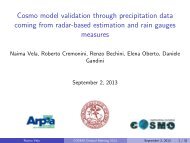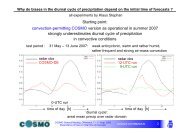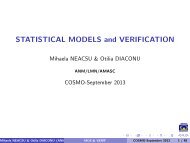Intercomparison of European Fog Forecast Models - Cosmo
Intercomparison of European Fog Forecast Models - Cosmo
Intercomparison of European Fog Forecast Models - Cosmo
You also want an ePaper? Increase the reach of your titles
YUMPU automatically turns print PDFs into web optimized ePapers that Google loves.
COSMO User’s Seminar<br />
Langen, March 2008<br />
<strong>Intercomparison</strong> <strong>of</strong> <strong>European</strong><br />
<strong>Fog</strong> <strong>Forecast</strong> <strong>Models</strong><br />
M.Masbou 1,2 , A. Bott 1 , M. D. Müller 3 , N. W.Nielsen 4 , C. Petersen 4 ,<br />
H. Seidl 5 , A. Kann 5 , J. Cermak 6 , H. Petithomme 7 & W. K. Adam 8<br />
1 Meteorological Institute, University <strong>of</strong> Bonn, Germany, mmasbou@uni-bonn.de<br />
2 Laboratoire de Météorologie physique, University Blaise Pascal, Clermont-Ferrand, France<br />
3<br />
Institute <strong>of</strong> Meteorology, Climatology & Remote Sensing, University <strong>of</strong> Basel, Switzerland<br />
4<br />
Danish Meteorlogical Institute, Copenhagen, Denmark<br />
5<br />
Central Institute for Meteorology and Geodynamics, Vienna, Austria<br />
6<br />
Laboratory for Climatology & Remote Sensing, University <strong>of</strong> Marburg, Germany<br />
7<br />
Meteo France, Toulouse, France<br />
8<br />
Meteorological Observatory Lindenberg, DWD, Germany<br />
COST-722
<strong>Fog</strong> Formation<br />
•Cooling<br />
•Moistening<br />
•Turbulent Mixing<br />
1D<br />
3D<br />
Reach saturation<br />
Radiation fog<br />
Advection fog<br />
(1D)<br />
3D<br />
3D<br />
Precipitation fog<br />
Upslope fog<br />
Valley fog
<strong>Fog</strong>: A visibility reduction<br />
1.4km<br />
1km<br />
0.5 km<br />
100 m<br />
50 m
COST 722 Project<br />
Development <strong>of</strong> advanced methods for short-range<br />
forecasts <strong>of</strong> fog, visibility and low clouds<br />
Working Group I: Initial Data<br />
• Improved calibration and analysis <strong>of</strong> satellite data<br />
• Recommendation <strong>of</strong> measurement equipments<br />
• Exchange <strong>of</strong> knowledge and methods<br />
Working Group II: Numerical <strong>Models</strong><br />
• Developement <strong>of</strong> numerical for fog and low clouds<br />
• Improved understanding <strong>of</strong> physical processes during fog events<br />
Working Group III: Statistical Methods<br />
• Powerful and highly sophisticated statisitcal methods<br />
• Improved expertise on statistical methods<br />
• Basis for the preparation <strong>of</strong> training material
Comparison Campaign on the Lindenberg Area<br />
September – December 2005<br />
Phase 1: Statistics<br />
Each Participant produce 4 month fog forecast and quantify statistically<br />
his fog forecast quality (FAR, HR, ETS)<br />
Phase 2: Fine Comparison for chosen fog/no fog events<br />
Episode 1: fog formation with mid cloud cover<br />
September, 27th 2005: 01-05 UTC<br />
Episode 2: fog formation with without cloud cover<br />
October, 6th 2005: 07-09 UTC<br />
October, 7th 2005: 06-08 UTC<br />
Episode 3: fog formation with 8/8 cloud cover<br />
December, 6th 2005: 18-00 UTC<br />
December, 7th 2005: 00-23 UTC
Lindenberg Area<br />
Observatory <strong>of</strong> DWD supplies:<br />
• Visibility 2m<br />
• Cloud cover<br />
• Radiative fluxes<br />
(SW, LW, Latent and Sensible)<br />
• 10m-Mast: T, RH, Wind<br />
• 100m-Mast: T, RH, Wind<br />
• Radiosounding<br />
(00, 06, 12 and 18 UTC)<br />
• Soil temperature<br />
• Soil moisture
Participants<br />
Statistical Model: MOS-ARPEGE<br />
France: H. Petithomme<br />
MOS statistics using linear discriminant analysis<br />
Uses model output <strong>of</strong> the hydrostatic global model ARPEGE<br />
Predictand:<br />
Predictor:<br />
visibility with different thresholds<br />
pressure at the ground, cloud cover, 10m wind<br />
speed, RH2m, T2m
Model name:<br />
Resolution:<br />
Model domain:<br />
Boundary values:<br />
Dynamics:<br />
Turbulence:<br />
Visibility:<br />
Operational models<br />
Austria: H. Seidl and A. Kann<br />
Model name:<br />
Resolution:<br />
Model domain:<br />
Boundary values:<br />
Dynamics:<br />
Turbulence:<br />
Visibility:<br />
ALADIN-AUSTRIA<br />
9.6 km horizontal, 45 vertical layers<br />
Europe<br />
global model ARPEGE<br />
Hydrostatic<br />
Louis scheme<br />
Post-processing in case <strong>of</strong> T-inversion<br />
gradient RH and T<br />
Denmark: C. Petersen and N.W. Nielsen<br />
DMI-HIRLAM<br />
16 km horizontal, 40 vertical layers<br />
Europe<br />
ECMWF analyses and forecasts<br />
Hydrostatic<br />
prognostic TKE<br />
MOS approach depending on ground<br />
measurements and model forecasts
Turbulence:<br />
Visibility:<br />
Non-operational models<br />
Germany: M. Masbou and A. Bott<br />
Model name:<br />
LM-PAFOG (COSMO-FOG)<br />
Resolution: 2.8 km horizontal, 40 vertical layers, Δz min =4m<br />
Model domain: 280 x 280 km limited area<br />
Boundary values: COSMO-EU<br />
Dynamics:<br />
Turbulence:<br />
Visibility:<br />
Switzerland: M.D. Müller<br />
Model name:<br />
Resolution:<br />
Model domain:<br />
Boundary values:<br />
Dynamics:<br />
Nonhydrostatic, fully compressible<br />
Louis scheme<br />
diagnostic variable depending on CCN, LWC,<br />
aerosol concentration at 2m<br />
NMM-PAFOG<br />
1 km horizontal, 45 vertical layers<br />
160 x 160 km limited area<br />
NMM 13 km<br />
Nonhydrostatic, fully compressible<br />
prognostic TKE<br />
complex relation <strong>of</strong> moist forecasted<br />
parameter at 2m
Statistical Study<br />
METHOD<br />
Comparison 1 pixel <strong>of</strong> Model area with visibility 2m<br />
5 Categories: < 350m, < 600m, < 1000m, < 1500m, < 3000m<br />
Basing on contingence table analyses<br />
PERIOD<br />
4 months forecast (September-December 2005)<br />
MODELS<br />
Initialization:<br />
each day at 00 UTC<br />
FOG CLIMATOLOGY<br />
35 <strong>Fog</strong> events<br />
<strong>Fog</strong> episode very rare, 4 % <strong>of</strong> studied time period
Ensemble <strong>Forecast</strong><br />
To analyse the basic quality <strong>of</strong> the <strong>European</strong> models<br />
Ensemble forecast extracted from the 4 models<br />
n<br />
1<br />
P = ∑ P<br />
ens<br />
n<br />
i<br />
i=<br />
1<br />
P ens<br />
P i<br />
<strong>Fog</strong> event probability <strong>of</strong> the<br />
ensemble<br />
<strong>Fog</strong> event probability <strong>of</strong><br />
the i-th model<br />
n<br />
Quantity <strong>of</strong> available<br />
forecasts<br />
Average out disagreements<br />
between ensemble member
Hit Rate<br />
What fraction <strong>of</strong> the observed “fog" events were correctly forecast?<br />
BLACK:LM-PAFOG RED:ENSEMBLE GREEN:HIRLAM<br />
MAGENTA:MOS-ARPEGE<br />
BLUE:ALADIN
False Alarm Rate<br />
What fraction <strong>of</strong> the observed "no-fog" events were incorrectly forecast as “fog"?<br />
BLACK:LM-PAFOG RED:ENSEMBLE GREEN:HIRLAM<br />
MAGENTA:MOS-ARPEGE<br />
BLUE:ALADIN
False Alarm Ratio<br />
What fraction <strong>of</strong> the predicted “fog" events actually did not occur<br />
(i.e., were false alarms)?<br />
BLACK:LM-PAFOG RED:ENSEMBLE GREEN:HIRLAM<br />
MAGENTA:MOS-ARPEGE<br />
BLUE:ALADIN
Equitable Threat Score<br />
How well did the forecast “fog" events correspond to the observed “fog" events?<br />
BLACK:LM-PAFOG RED:ENSEMBLE GREEN:HIRLAM<br />
MAGENTA:MOS-ARPEGE<br />
BLUE:ALADIN
Case I: Visibility 2m<br />
Date: September, 26-27 th 2005<br />
After a rain episode bringing warm and humid air, residual cloud<br />
parcel<br />
Radiative fog
Visibility 2m: case I<br />
Legend:<br />
Vis 1000 m<br />
Vis<br />
LWC 2m: case I<br />
Legend:<br />
LWC> 0.1g/kg<br />
>0.01 g/kg<br />
LWC<br />
Case I: Vertical pr<strong>of</strong>ile at Lindenberg<br />
BLACK:OBSERVED RED:LM-PAFOG GREEN:ALADIN<br />
BLUE:HIRLAM<br />
CYAN= NMM-PAFOG
Case I: Radiative Fluxes
Case I: Close to the ground
Case II: Visibility 2m<br />
Date: December, 6-7 th 2005<br />
Stable moist layer with a tendency to light rain, full cloud cover<br />
Low stratus and <strong>Fog</strong>
Visibility 2m: case II<br />
Legend:<br />
Vis 1000 m<br />
Vis<br />
LWC 2m: case II<br />
Legend:<br />
LWC> 0.1g/kg<br />
>0.01 g/kg<br />
LWC<br />
Case II: Vertical pr<strong>of</strong>ile at Lindenberg<br />
BLACK:OBSERVED RED:LM-PAFOG GREEN:ALADIN<br />
BLUE:HIRLAM<br />
CYAN= NMM-PAFOG
Case II: Radiative Fluxes
Case II: Close to the ground
CONCLUSION<br />
4 <strong>Models</strong> involved NO BEST MODEL<br />
• MOS-ARPEGE: statistic model<br />
• ALADIN-AUSTRIA, DMI-HIRLAM:<br />
3D mesoscale models, ad hoc cloud water near the surface<br />
• NMM-PAFOG, LM-PAFOG :<br />
3D high-resolution fog forecast model, complex microphysics<br />
Statistical and fine Analysis <strong>of</strong> autumn 2005´s fog events<br />
• 20 % <strong>of</strong> the fog forecast according with measurements<br />
• Initialization and Assimilation <strong>of</strong> the boundary layer<br />
determinant role for a successful fog forecast<br />
• Visibility parameterization: decisive key<br />
• Vertical diffusion usually not designed to work well<br />
near the surface
Outlooks<br />
• Adapted turbulent scheme for high vertical resolution<br />
• Long time verification <strong>of</strong> 3D fog forecast model considering<br />
spatial distribution <strong>of</strong> fog<br />
• Adjusting the visibility parameterization<br />
Thanks<br />
COST 722
Parameters in <strong>Fog</strong> Formation<br />
Important Parameters in <strong>Fog</strong> Formation<br />
Cooling <strong>of</strong> moist air by radiative flux divergence<br />
Vertical mixing <strong>of</strong> heat and moisture<br />
Vegetation<br />
Horizontal and vertical wind<br />
Heat and moisture transport in soil<br />
Advection<br />
Topographic effect<br />
(Duynkerke, P.G.,1991)<br />
Once the fog has formed<br />
Longwave radiative cooling at fog top<br />
Gravitational droplet settling<br />
<strong>Fog</strong> microphysics<br />
Shortwave radiation
What is FOG ?<br />
WMO definition<br />
“Suspension <strong>of</strong> very small, usually microscopic water<br />
droplets in the air, generally reducing the horizontal<br />
visibility at the Earth´s surface to less than 1km”<br />
<strong>Forecast</strong>er definition (Roach, W.T., 1994)<br />
“<strong>Fog</strong> occurs whenever the horizontal visibility falls below<br />
1km. Cloud base descending to ground level is also<br />
experienced as fog.”
Case III: Visibility 2m<br />
Date: October, 6-7 th 2005<br />
Under influence <strong>of</strong> high pressure system, no cloud cover<br />
Radiative fog
Visibility 2m: case III<br />
Legend:<br />
Vis 1000 m<br />
Vis<br />
LWC 2m: case III<br />
Legend:<br />
LWC> 0.1g/kg<br />
>0.01 g/kg<br />
LWC<br />
Case III: Vertical pr<strong>of</strong>ile at Lindenberg<br />
BLACK:OBSERVED RED:LM-PAFOG GREEN:ALADIN<br />
BLUE:HIRLAM<br />
CYAN= NMM-PAFOG
Case III: Radiative Fluxes
Case III: Close to the ground








